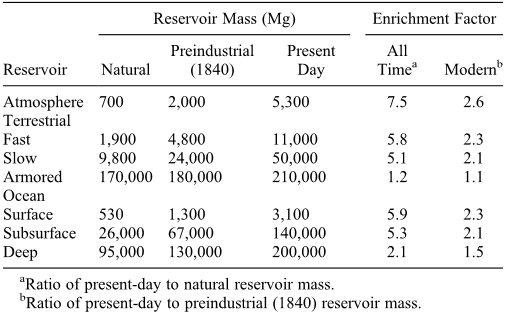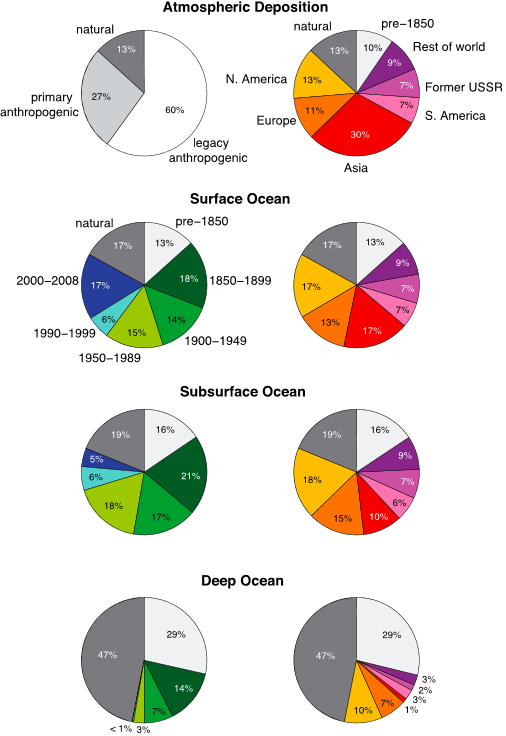Legacy impacts of all‐time anthropogenic emissions on the global mercury cycle
Figures (10)

Table 2. Hg Reservoir Masses and Historical Anthropogenic Enrichments 
Figure 3. Simulated present-day global Hg budget and all-time anthropogenic enrichments factors. Terrestrial-atmosphere exchange is given in the top panel for the sum of terrestrial reservoirs. The bottom panel shows the breakdown and cycling between the different terrestrial reservoirs. All terrestrial reservoirs receive inputs from Hg(II) deposition (fast = 800, slow= 510, and armored = 280Mg a 1). The fast reservoir also receives inputs from Hg(0) deposition (1600Mg a 1). All terrestrial reservoirs lose Hg through respiration (fast = 520, slow= 360, and armored =30Mg a 1) and biomass burning (fast = 320, slow = 9, and armored = 5Mg a 1). Photoreduction from the fast terrestrial reservoir is 950Mg a 1. 
Table 1. Present-Day Hg Reservoirs and Flowsa 
Figure 8. Change in reservoir masses relative to 2015 under a scenario of zero primary anthropogenic emissions after 2015. 
Figure 7. Natural and anthropogenic contributions to present-day atmospheric deposition and ocean reservoirs. The contribution from natural Hg is defined by steady state in our biogeochemical model without anthropogenic emissions. The primary anthropogenic contribution to deposition is from direct emissions (Figure 2a), while the legacy contribution is from anthropogenic Hg previously deposited and then re-emitted by surface reservoirs. The contribution from legacy Hg is calculated as total deposition minus primary anthropogenic emissions and natural emissions. For the ocean reservoirs, we partition the anthropogenic contribution by time period (left column) and region (right column). “Rest of world” includes Africa, the Middle East, and Oceania. 
Figure 1. Rate coefficients kij (a 1) driving our sevenreservoir global biogeochemical box model for Hg. kij defines the first-order transfer from reservoir i to reservoir j as Fij = kijmi, where Fij (Mg a 1) is the Hg flow from reservoir i to reservoir j and mi (Mg) is the mass of Hg in reservoir i. Values of kij are derived from best estimates of present-day flows andmasses from the literature (Table 1) and are assumed to be constant in time. The red arrow represents the external forcing by primary emissions (geogenic or anthropogenic) from the deep mineral reservoir. Geogenic emissions are constant (90Mg a 1), and anthropogenic emissions are time dependent (Figure 2). 
Figure 4. Normal modes of the Hg biogeochemical model. Each column describes an eigenvector of the mass transfer matrixK and represents a normal mode of the system. Perturbation to a normal mode decays exponentially with a timescale equal to the inverse of the corresponding eigenvalue. These timescales are displayed above the modes. The elements of the eigenvectors indicate the coupling between reservoirs associated with each timescale. For example, Mode 1 (0.2 years) describes a strong coupling between the surface and subsurface ocean reservoirs, and a weak coupling with the atmosphere. Mode 2 (0.8 years) describes a strong coupling between the atmosphere and subsurface ocean. Figure 5 gives a schematic summary of the information in this figure, highlighting the dominant couplings associated with each mode. 
Figure 5. Characteristic timescales (years) for Hg biogeochemical cycling derived from eigenanalysis of our sevencompartment box model (see section 4.1). The arrows indicate the principal reservoirs coupled over each timescale. These couplings often involve a combination or succession of transfers through intermediate reservoirs. More details are presented in Figure 4. 
Figure 6. Time-dependent rate of a pulse of Hg released to the atmosphere (top), fast terrestrial pool (middle), or surface ocean (bottom). A unit pulse of Hg is injected into the corresponding reservoir at time t = 0 years, and the resulting mass fraction from that pulse in individual reservoirs is plotted as a function of time. Note the log scale for time. ![Figure 2. History of global anthropogenic influence on environmental Hg: (a) primary anthropogenic emissions to the atmosphere, (b) corresponding cumulative emissions, (c) atmospheric deposition, and (d) combined surface + subsurface ocean mercury concentrations. The 1850–2008 emissions are from Streets et al. [2011]. Pre-1850 emissions are as described in the text. Post-2008 emissions assume the business-as-usual A1B scenario of Streets et al. [2009] from 2008 to 2015 and different hypothetical emission trajectories afterward as described in the text.](/figures/figure-2-history-of-global-anthropogenic-influence-on-16xvmtkg.png)
Figure 2. History of global anthropogenic influence on environmental Hg: (a) primary anthropogenic emissions to the atmosphere, (b) corresponding cumulative emissions, (c) atmospheric deposition, and (d) combined surface + subsurface ocean mercury concentrations. The 1850–2008 emissions are from Streets et al. [2011]. Pre-1850 emissions are as described in the text. Post-2008 emissions assume the business-as-usual A1B scenario of Streets et al. [2009] from 2008 to 2015 and different hypothetical emission trajectories afterward as described in the text.
Citations
1,631 citations
634 citations
431 citations
Cites background from "Legacy impacts of all‐time anthropo..."
...…using additional observational constraints (Streets et al. 2011; Horowitz et al. 2014) estimate higher present-day organic soil Hg pools (250–1000 Gg with a best estimate of 500 Gg) and propose that anthropogenic activities have doubled the Hg stored in organic soils (Amos et al. 2013, 2015)....
[...]
...…of modeling tools that collapse the necessary detail from global simulations into more computationally feasible geochemical box models, enabling fully coupled simula- tions of the interactions among the land, atmosphere, and oceans over millennial time scales (Amos et al. 2013, 2014, 2015)....
[...]
...…atmospheric Hg reservoir is estimated to be between 4400 and 5300 Mg, and is enriched by more than an order of magnitude relative to natural levels and by approximately three- to fivefold relative to 1850 levels (Amos et al. 2013; Engstrom et al. 2014; Horowitz et al. 2017; Streets et al. 2017)....
[...]
...Amos et al. (2013) predicted that legacy Hg will be present in global ecosystems for periods ranging from decades to millennia, suggesting a large time lag in response to changes in anthropogenic emissions and climate....
[...]
383 citations
296 citations
References
2,398 citations
2,345 citations
"Legacy impacts of all‐time anthropo..." refers methods in this paper
...Based on the work of Nriagu [1993] and Streets et al....
[...]
1,240 citations
1,027 citations
972 citations
"Legacy impacts of all‐time anthropo..." refers background in this paper
...[4] Sedimentary and ice core records provide evidence of a two- to five-fold enrichment in present-day atmospheric Hg deposition relative to preindustrial (ca. 1840) levels [Fitzgerald et al., 1998; Schuster et al., 2002; Biester et al., 2007; Lindberg et al., 2007]....
[...]
...Although Asia is presently the dominant contributor to primary anthropogenic emissions, only 17% of the surface ocean reservoir is of Asian anthropogenic origin, as compared to 30% of North American and European origin....
[...]